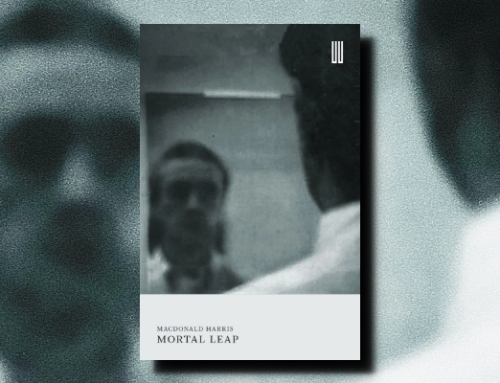Swimmer in the Secret Sea by William Kotzwinkle (1975) David R. Godine (2010) 96 pp
I’ve had my eye on Swimmer in the Secret Sea since I read about it earlier this year and saw that it was published by Godine, one of my favorite publishers. As happens, though, I put off purchasing it online, which is the only place I thought I would find it. However, last month my wife and I were driving around and decided to take a little detour to Montclair, a lovely town just north of us. I slammed on my breaks when I saw an independent bookstore on the corner by the train station. I could have spent all day browsing at the Watchung Booksellers — I’m sure to my family it felt that way; they had loads of interesting books that you just don’t see in the major bookstores. I was delighted to find this painful novella on their shelf.
This short book (just under 100 pages of generously large type and margins) was originally published in Redbook, but in the same year it was published as a paperback. I believe it is a rare thing for a magazine short story to find its way into its own cover. To remain in print through the years is also quite a feat. Off the top of my head, I can think of only one other that has similar success: Cynthia Ozick’s The Shawl (and even it is actually two stories).
The story of Swimmer in the Secret Sea couldn’t be simpler. It begins when Diane’s water breaks and Laski runs out to to start the truck:
“I’ll get the truck warmed up.” He went outside into the snow. Beyond the shadowy tops of the pines the vast sky bowl-glittered, and the half-ton truck sat in the moonlight, covered with brightly sparkling ice. He opened the door and slid in, pulling on the choke and turning the ignition key.
Laski and Diane are expecting their first child. I have two young children, so I remember well how the general anxiety just before the delivery mixes with a strange calm (or is it numbness?). Kotzwinkle wonderfully captures these contradicting feelings perfectly.
It seemed to Laski there were two distinct Dianes — one who was shaking like a leaf, and another who was as calm and decisive as any old midwife. He felt the same split in himself as he picked up her valise and carried it toward the stairs. His hand was trembling, his heart pounding, but another part of him was calm, unshakable as an old tree. This calm quiet partner seemed to dwell in some region of the body Laski couldn’t identify. His guts were jumping, his brain was racing, his legs were shaking, but somewhere in him there was peace.
Sadly — and this is no spoiler because it happens at the beginning — the child, whose heartbeat we’ve just heard, dies during labor. Laski and Diane are forced to go back to their cold home and bury the child. The couple doesn’t even know this child, yet they feel its loss greatly. The child had, after all, been with them for nine months, and they had prepared for a life with it. Any comfort the doctors and nurses try to give — the good news is that this is unlikely to happen again; you will certainly be able to have another — just doesn’t cut it: “He thinks that’s what has been at stake, our wish for a child, any child, not this particular child who swung down the road between us. They can’t know how special he is.”
The book’s strength is the simple story, the seemingly simple way it is told, and the cold landscape that all at once emphasizes the book’s tragedy and its hope. The anxiety and the calm, a landscape that is both lonely and comforting, a child that never arrived but is deeply missed, tragedy and hope — or is there really any hope at all here? Such contradictions give the simplicity a full range of emotion. Another strength: the book’s ability to make the reader question any warmth he or she may be feeling.
This novella is depressing, but it also contains a lot of beauty.









Hi Trevor, at the risk of sounding odd, I enjoyed learning that you’re married and have two children. Visiting a person’s blog is often more enjoyable when you can form a kind of picture of them, sans creepiness. I’m sure you know what I mean. Anyhow, I plan to longlist this book because I’m pro simplicity, melancholoy, and beauty. Cheers, K
I do know what you mean, Kevin. And it’s not creepy. Unless you would have found less enjoyment had I had three boys or only one. If you enjoy learning more about the voice behind this blog, not creepy :).
I’ll be interested in your thoughts here, Kevin, as always. I completely enjoy how you parsed up the Winged Mercury metaphor in “To Build a Fire” the other day, and I’d love to get the benefit of your eye on this one.
Wow, Kevin, the story as you have summarised it is not at all as I might have expected from the title.
This might be another odd comment …
But; I really like the picture on the front cover of this book, the atmosphere in it seems to be one of emptiness and isolation – even if (or maybe because of) the lights reflected in the snow.
Right now I’m reading Césa Aira – which you have written well about earlier – Kotzwinkle is already on my “to read” list
I agree, Sigrun. The thing I like about the picture is that it can be empty and isolated, but my experience driving around in such a landscape is that it also can feel warm and enclosed. It’s quiet and peaceful. I think that combination perfectly illustrates the contradictions/complements in the book.
And . . . don’t forget to let me know how you get on with Aira!
I also find the cover picture interesting — it echoes Maile Meloy and Alexander MacLeod, two collections that I loved.
The cold air in the book reminded me of both of those great collections, Kevin, so we’re on the same wave length there.
Though I must say that I don’t like this story (as much as I liked it) nearly as much as I liked Meloy and MacLeod.
Hm, being a Norwegian might not be a good excuse… but I haven’t heard of neither Maile Meloy nor Alexander MacLeod, but it sounds like you would recommend them both?
About Césa Aira: I’m reading “Un episodio en la vida del pintor Viajero”, or: En episode i en omreisende malers liv (Norwegian). It caught me from page one. At the moment I’m very interested in this kind of cross-genre literature, the documentary/biography/fiction mix, which most of the time doesn’t work at all, but which in hands of the best writers makes excellent books.
I’m reading Aira as a critic, next on my list is an literary essay on “Don Qijote” – it seems like I’m in a flock of men on horses …
Ah, Sigrun, you have obviously missed some of my posts and comments if you wonder whether I would recommend Maile Meloy and Alexander MacLeod. I believe people are getting sick of it, but you’ve given me one more chance to express how much I love Maile Meloy’s collections of short stories, Both Ways Is the Only Way I Want It and Half in Love (I haven’t read her two novels yet, though the time is coming). As for Alexander MacLeod, his Light Lifting was the Shadow Giller’s unanimous pick for this year’s Giller Prize. Light Lifting is also a book of short stories. I don’t think it is as strong as Meloy’s, but it is certainly a wonderful book from a promising young author.
By the way, several of Meloy’s stories take place in Montana, so you’ll get some horses there too :) .
Next to the library, for a writer, the small bookstore you describe is a sacred space.
Based on the lines you pulled from the book, I have to wonder how the story reminded you of the birth of your two sons. I don’t recall any split personalities.
Hmmm, looks like tonight I will have to watch out for the angry wife :).
Hi Trevor, On the same theme there is a wonderful Dutch novella which has been translated into English: Shadow Child, by P.F. Thomese. Depressing, moving, yet unsentimental and one of those books that will stick with me for the rest of my life. P.F. Thomese based it on his own experiences; he lost his baby daughter shortly after she was born. The novella is his search to give this a place in his life.
A bit late, but: I’ve read it & I love it!
In your review you write: “The anxiety and the calm, a landscape that is both lonely and comforting, a child that never arrived but is deeply missed, tragedy and hope — or is there really any hope at all here?”
For me the hope in this story is to be found in the beautiful connectedness there seems to be between husband and wife, it looks as if they are able to share the sadness. Hopelessness would be if they were unable to share their feelings, unable talk about the tragedy.
As I read it – there is a kind of warmth in the story, despite the tragedy, the emptiness and the icy snow, maybe it is this combination of sadness and softness that makes this such a great read?
That’s a great point, Sigrun, and one I hadn’t thought of. We don’t necessarily see how well they are going to hold up after the little funeral, but we do get a sense they will get through it together — and that is very hopeful.
And I think you’re right about why the book is successful: it’s that combination of disparate feelings.